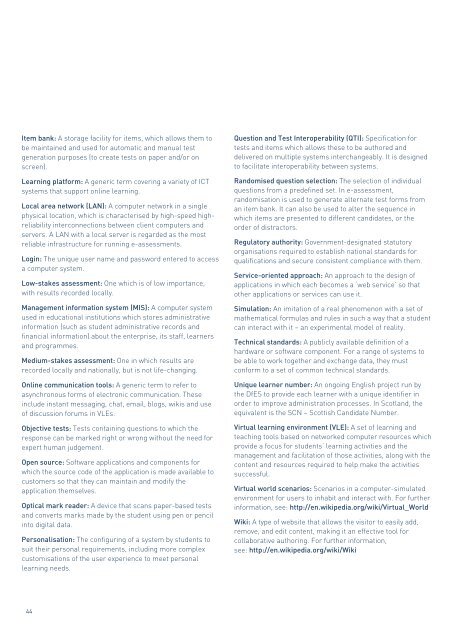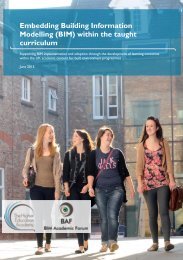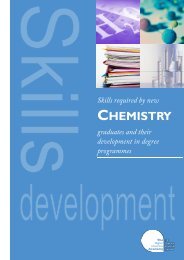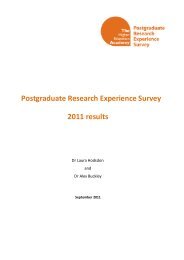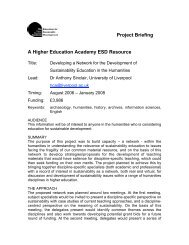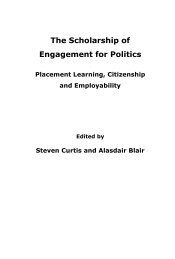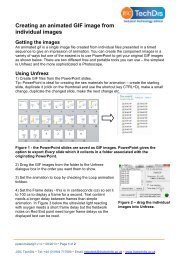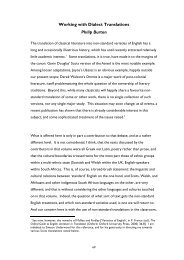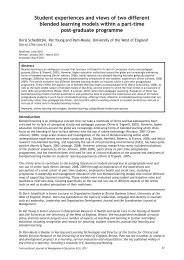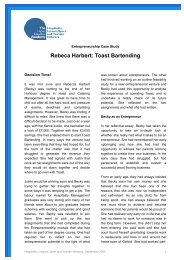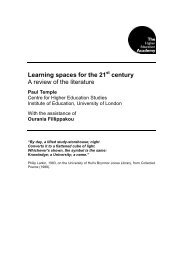Effective Practice with e-Assessment: An overview of ... - Jisc
Effective Practice with e-Assessment: An overview of ... - Jisc
Effective Practice with e-Assessment: An overview of ... - Jisc
You also want an ePaper? Increase the reach of your titles
YUMPU automatically turns print PDFs into web optimized ePapers that Google loves.
Item bank: A storage facility for items, which allows them to<br />
be maintained and used for automatic and manual test<br />
generation purposes (to create tests on paper and/or on<br />
screen).<br />
Learning platform: A generic term covering a variety <strong>of</strong> ICT<br />
systems that support online learning.<br />
Local area network (LAN): A computer network in a single<br />
physical location, which is characterised by high-speed highreliability<br />
interconnections between client computers and<br />
servers. A LAN <strong>with</strong> a local server is regarded as the most<br />
reliable infrastructure for running e-assessments.<br />
Login: The unique user name and password entered to access<br />
a computer system.<br />
Low-stakes assessment: One which is <strong>of</strong> low importance,<br />
<strong>with</strong> results recorded locally.<br />
Management information system (MIS): A computer system<br />
used in educational institutions which stores administrative<br />
information (such as student administrative records and<br />
financial information) about the enterprise, its staff, learners<br />
and programmes.<br />
Medium-stakes assessment: One in which results are<br />
recorded locally and nationally, but is not life-changing.<br />
Online communication tools: A generic term to refer to<br />
asynchronous forms <strong>of</strong> electronic communication. These<br />
include instant messaging, chat, email, blogs, wikis and use<br />
<strong>of</strong> discussion forums in VLEs.<br />
Objective tests: Tests containing questions to which the<br />
response can be marked right or wrong <strong>with</strong>out the need for<br />
expert human judgement.<br />
Open source: S<strong>of</strong>tware applications and components for<br />
which the source code <strong>of</strong> the application is made available to<br />
customers so that they can maintain and modify the<br />
application themselves.<br />
Optical mark reader: A device that scans paper-based tests<br />
and converts marks made by the student using pen or pencil<br />
into digital data.<br />
Personalisation: The configuring <strong>of</strong> a system by students to<br />
suit their personal requirements, including more complex<br />
customisations <strong>of</strong> the user experience to meet personal<br />
learning needs.<br />
Question and Test Interoperability (QTI): Specification for<br />
tests and items which allows these to be authored and<br />
delivered on multiple systems interchangeably. It is designed<br />
to facilitate interoperability between systems.<br />
Randomised question selection: The selection <strong>of</strong> individual<br />
questions from a predefined set. In e-assessment,<br />
randomisation is used to generate alternate test forms from<br />
an item bank. It can also be used to alter the sequence in<br />
which items are presented to different candidates, or the<br />
order <strong>of</strong> distractors.<br />
Regulatory authority: Government-designated statutory<br />
organisations required to establish national standards for<br />
qualifications and secure consistent compliance <strong>with</strong> them.<br />
Service-oriented approach: <strong>An</strong> approach to the design <strong>of</strong><br />
applications in which each becomes a ‘web service’ so that<br />
other applications or services can use it.<br />
Simulation: <strong>An</strong> imitation <strong>of</strong> a real phenomenon <strong>with</strong> a set <strong>of</strong><br />
mathematical formulas and rules in such a way that a student<br />
can interact <strong>with</strong> it – an experimental model <strong>of</strong> reality.<br />
Technical standards: A publicly available definition <strong>of</strong> a<br />
hardware or s<strong>of</strong>tware component. For a range <strong>of</strong> systems to<br />
be able to work together and exchange data, they must<br />
conform to a set <strong>of</strong> common technical standards.<br />
Unique learner number: <strong>An</strong> ongoing English project run by<br />
the DfES to provide each learner <strong>with</strong> a unique identifier in<br />
order to improve administration processes. In Scotland, the<br />
equivalent is the SCN – Scottish Candidate Number.<br />
Virtual learning environment (VLE): A set <strong>of</strong> learning and<br />
teaching tools based on networked computer resources which<br />
provide a focus for students’ learning activities and the<br />
management and facilitation <strong>of</strong> those activities, along <strong>with</strong> the<br />
content and resources required to help make the activities<br />
successful.<br />
Virtual world scenarios: Scenarios in a computer-simulated<br />
environment for users to inhabit and interact <strong>with</strong>. For further<br />
information, see: http://en.wikipedia.org/wiki/Virtual_World<br />
Wiki: A type <strong>of</strong> website that allows the visitor to easily add,<br />
remove, and edit content, making it an effective tool for<br />
collaborative authoring. For further information,<br />
see: http://en.wikipedia.org/wiki/Wiki<br />
44


